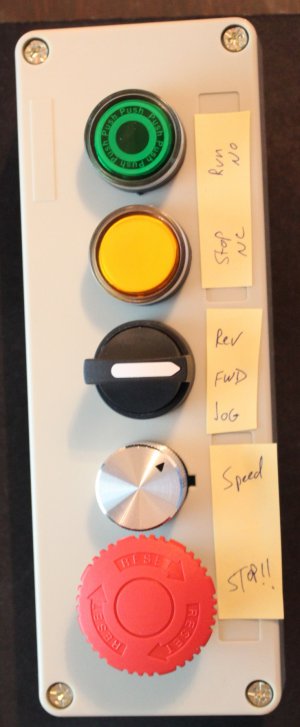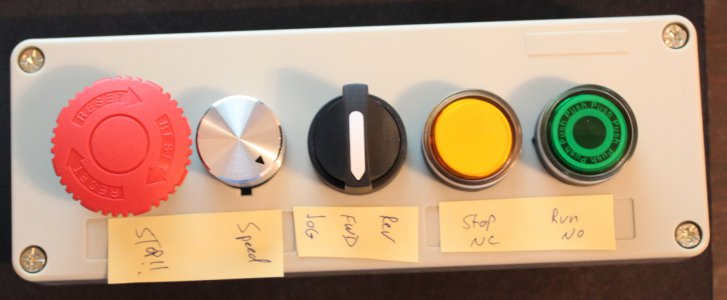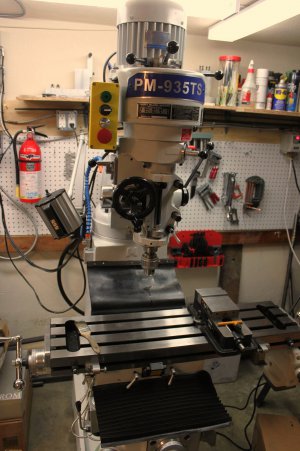- Joined
- Nov 2, 2012
- Messages
- 415
My VFD is supposed to be here tomorrow, and I'm planning my remote control wiring in anticipation, but I'm still trying to wrap my brain around setting up the basic functions I want. Could anyone that's got a handle on this stuff give me some feedback, even if you need to point out what I'm doing is stupid? I bought switches and such before actually figuring this out, but I think I'm close with what I've got on hand. This is the box as I'm intending to lay it out:

First, this will be PNP, so 24 VDC runs through the various switches and buttons, and on to the individual terminals 1-7 as needed. I'm using the 3 wire interface, so the green run button is normal open, the yellow (wish I bought red) stop button is normal closed, and the three-position switch will be normal open for Reverse, nothing (off) for Forward, and normal open for Jog (the F/R logic might be backward because pages 3-86 and 4-31 seem to be in conflict.) The e-stop is normal open. The pot is a 10k from Radio Shack and will go to terminals H/O/L.
Not that this is necessary information since the terminals are customizable, but I plan to use Run=3, Stop=4, Reverse=5 (unless backward), nothing for forward (unless backward), Jog=2, e-Stop=1. So far, does this sound proper?
Now the questions about the switches themselves (these are Autonics products in case it matters.)
1. The contact blocks for switch functions are all labeled 220VAC, 5A 110VAC,10A. Since these are just on/off switches, no problem, right?
2. The green/yellow buttons are lit by LED contact blocks that are labeled 100-220 VAC, 10mA, but I would think to to work with 24VDC I'd need to buy the 12-30VAC/DC versions. Yes?
3. How should the LEDs be powered? 24VDC->LED->L (GND)?
4. Is there a way to use the LED blocks that I have if 24VDC won't do it?
5. Are these sorts of buttons normally on when the VFD is powered up? I have a switch to turn power off to the VFD because it normally only sees weekend use. If so, they'd come on with that switch.
6. I lucked out hooking up the pot on my Benchmaster. Is there some way to tell or know which wire is used for what?
Am I missing anything or heading down the wrong path? I appreciate any input.
The manual is located here: http://www.hitachi-america.us/supportingdocs/forbus/inverters/Support/WJ200_Instruction_NT325X.pdf
Thanks,
Ryan



First, this will be PNP, so 24 VDC runs through the various switches and buttons, and on to the individual terminals 1-7 as needed. I'm using the 3 wire interface, so the green run button is normal open, the yellow (wish I bought red) stop button is normal closed, and the three-position switch will be normal open for Reverse, nothing (off) for Forward, and normal open for Jog (the F/R logic might be backward because pages 3-86 and 4-31 seem to be in conflict.) The e-stop is normal open. The pot is a 10k from Radio Shack and will go to terminals H/O/L.
Not that this is necessary information since the terminals are customizable, but I plan to use Run=3, Stop=4, Reverse=5 (unless backward), nothing for forward (unless backward), Jog=2, e-Stop=1. So far, does this sound proper?
Now the questions about the switches themselves (these are Autonics products in case it matters.)
1. The contact blocks for switch functions are all labeled 220VAC, 5A 110VAC,10A. Since these are just on/off switches, no problem, right?
2. The green/yellow buttons are lit by LED contact blocks that are labeled 100-220 VAC, 10mA, but I would think to to work with 24VDC I'd need to buy the 12-30VAC/DC versions. Yes?
3. How should the LEDs be powered? 24VDC->LED->L (GND)?
4. Is there a way to use the LED blocks that I have if 24VDC won't do it?
5. Are these sorts of buttons normally on when the VFD is powered up? I have a switch to turn power off to the VFD because it normally only sees weekend use. If so, they'd come on with that switch.
6. I lucked out hooking up the pot on my Benchmaster. Is there some way to tell or know which wire is used for what?
Am I missing anything or heading down the wrong path? I appreciate any input.
The manual is located here: http://www.hitachi-america.us/supportingdocs/forbus/inverters/Support/WJ200_Instruction_NT325X.pdf
Thanks,
Ryan




